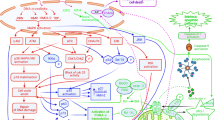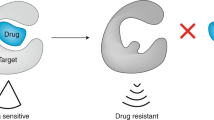Abstract
Drug resistance is a well recognized problem in cancer therapy. Despite the current dogma that drug resistance is always an obstacle for treatment, here I show that it provides opportunities for selective protection of non-resistant cells with killing of drug-resistant cancer cells. According to the proposed ‘two-drug’ strategy, the first drug should be ineffective against a target drug-resistant cell (ie the drug is a substrate of MRP or Pgp pumps). In addition, it must be cytostatic but not cytotoxic. The second drug, which is applied in sequence, must be a cycle-dependent apoptotic drug to which the target cell is not cross-resistant. Thus, low doses of adriamycin, etoposide and actinomycin D, used as the first drugs, were cytostatic to parental HL60 cells. Therefore, these drugs precluded Bcl-2/Raf-1 phosphorylation, PARP cleavage and cell death which are otherwise induced by paclitaxel, a mitosis-selective apoptotic drug for HL60 cells. In contrast, HL60/ADR cells which express MRP, a transporter which pumps out the first drugs from a cell, were insensitive to the first drugs and therefore readily underwent apoptosis following the second drug. This strategy also allowed a selective killing of HL60/TX cells which express MDR-1, with the only difference being that the second drug, paclitaxel, was substituted for epothilones, non-Pgp substrates. Lack of protection by the first drug, a Pgp substrate, resulted in HL60/TX killing by the second drug, whereas parental HL-60 cells were fully protected. Therefore, drug resistant cells can be selectively killed by a combination of drugs not killing sensitive cells. Lack of toxicity against normal cells will be clinically translated in reduction of adverse side-effects of chemotherapy against drug-resistant malignancies.
This is a preview of subscription content, access via your institution
Access options
Subscribe to this journal
Receive 12 print issues and online access
$259.00 per year
only $21.58 per issue
Buy this article
- Purchase on Springer Link
- Instant access to full article PDF
Prices may be subject to local taxes which are calculated during checkout
Similar content being viewed by others
Author information
Authors and Affiliations
Rights and permissions
About this article
Cite this article
Blagosklonny, M. Drug-resistance enables selective killing of resistant leukemia cells: exploiting of drug resistance instead of reversal. Leukemia 13, 2031–2035 (1999). https://doi.org/10.1038/sj.leu.2401623
Received:
Accepted:
Published:
Issue Date:
DOI: https://doi.org/10.1038/sj.leu.2401623
Keywords
This article is cited by
-
Suppressive drug combinations and their potential to combat antibiotic resistance
The Journal of Antibiotics (2017)
-
Drug interactions and the evolution of antibiotic resistance
Nature Reviews Microbiology (2009)
-
Sequential activation and inactivation of G2 checkpoints for selective killing of p53-deficient cells by microtubule-active drugs
Oncogene (2002)
-
Treatment with inhibitors of caspases, that are substrates of drug transporters, selectively permits chemotherapy-induced apoptosis in multidrug-resistant cells but protects normal cells
Leukemia (2001)
-
Enhanced ability of daniplestim and myelopoietin-1 to suppress apoptosis in human hematopoietic cells
Leukemia (2001)



